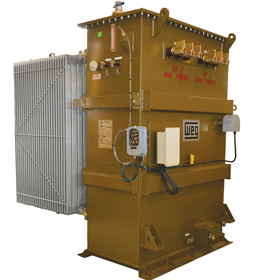

Zest WEG’s local transformer manufacturing facility has supplied 36 specialised photovoltaic (PV) transformers to a solar energy generation plant in the Northern Cape.
According to sales team leader, Stuart Brown, this heralds Zest WEG’s entry into the local production of transformers for the renewable energy sector. He stresses that conventional ‘off the shelf’ distribution transformers are not adequate for these applications. Distribution photovoltaic (DPV) solar energy transformers and generator step-up (GSU) wind turbine transformers are therefore specially designed.
“This exciting step into the renewables sector was achieved through our technical collaboration with WEG’s extensive research and development resources in Brazil,” Brown says. “We see great potential in the future of renewable energy solutions in Africa, especially as generation technologies evolve for the harnessing of solar and wind energy.”
“To ensure the highest standards, the design was reviewed by an international independent consultant,” says Ronaldo Bertoldi, engineering manager at the facility. The dual-system PV transformers were manufactured to the customer’s specification of 3800/1900-1900 kVA and 22/0,66-0,66 kV. The units were also subject to routine and type testing, including heat run, impulse and partial discharge tests. They were delivered to the project in batches between July and November 2019.
Bertoldi says the increasing use of renewable energy creates new demands and challenges for transformer design. “Transformers for wind and solar energy generation have installation and operation characteristics that strongly affect their design,” Bertoldi says. “The design must also continue to meet the requirements for quality and cost.” Among the specific factors affecting transformers in distribution photovoltaic (DPV) power generation systems is solar irradiation.
“This directly affects the load profile and the thermal stress in the transformer materials,” he says. “A wide range in transformer temperature must be accommodated – from minus 25 to plus 50 degrees Celsius.”
Transient overvoltage is also an issue to consider. On the high voltage (HV) side, overvoltage transients may occur due to multi-stage capacitor banks switching, or from the circuit breaker operation. On the low voltage (LV) side, voltages are controlled with high frequency inverters which create harmonics and pulsed voltages.
“An electrostatic ground shield is required between the primary and secondary windings to eliminate capacitive coupling and transient overvoltage transfers,” he says. “This also filters harmonics of high frequencies and pulsed LV voltages.”
Bertoldi notes that the International Electrotechnical Commission (IEC), Institute of Electrical and Electronics Engineers (IEEE) and the International Council on Large Electric Systems (CIGRÉ) are working to update standards related to this equipment. A number of international standards already apply.
“These include IEC 60076-16 standards for wind turbines, for transformers from 100 to 10 000 kVA, as well as dry-type and liquid-immersed transformers up to 72,5 kV,” he says. “The IEEE standard P57.159/D6 guides the design of transformers in DPV systems.”
The CIGRÉ standard WG A2.50 also applies to distributed energy sources and induced reverse power flow on transmission and distribution transformers. In addition to the local design and manufacture of transformers for renewable energy projects, Zest WEG can provide a range of integrated solutions for these projects. These include sub-station, e-houses, switchgear and inverters.
| Tel: | +27 11 723 6000 |
| Email: | [email protected] |
| www: | www.weg.net |
| Articles: | More information and articles about WEG Africa |

© Technews Publishing (Pty) Ltd | All Rights Reserved